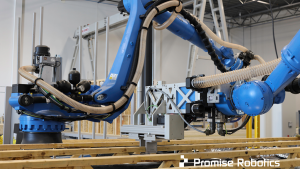The argument in favour of AI in construction is overwhelming, according to those who have already adopted it and the software companies bringing AI development forward. They claim the technology offers nothing short of a revolution for construction.
“AI data and automation aren’t just driving efficiencies. They’re reshaping how we build, collaborate, and solve challenges,” says Procore Technologies founder and CEO Tooey Courtemanche.
“This is one of the most transformative periods in the history of construction.”
Procore research indicates 55 per cent of construction leaders believe AI automation will disrupt the industry within the next five years. At the same time, hesitancy remains. Some surveys suggest levels of AI adoption in construction fall well below the pace of development being made by the technology.
Scott Laird, technical director at U.K. construction company Reds10, feels the industry should be excited about the potential of AI and how it could help boost the industry’s “woeful and long-standing low levels of productivity.”
“It is often said that construction is one of the few industries that allowed the industrial revolution to pass it by,” he writes. “Just look at housebuilding, where in many ways homes are still being built as they were 100 years ago, with contractors laying bricks in muddy fields.”
In Laird’s company, AI reduces the time that would have previously taken several weeks to optimize cladding design down to only a few minutes. It can quickly explore multiple planning options to optimize layouts based on rule sets. As a result, Laird says, “designers can focus on creativity rather than worrying about buildability, clashes or manufacturability.”
AI can help resolve other issues that cost time and money. According to a Future State of Construction Report released by Procore, 18 per cent of project time is currently lost searching for data, and 28 per cent is wasted due to rework.
However, AI adoption comes with costs. Many small and mid-size project partners cannot currently afford the financial commitment or the staff training required. This could cause them to miss out on the associated efficiency and productivity gains. Going forward, it could result in non-adopters becoming uncompetitive against those which do use AI.
During a recent webinar, Kris Lengienza, Procore’s VP of global partnerships and alliances, called AI his “Artificial Intern.” He said properly instructed, the technology can, for example, summarize a series of internal reports in seconds, versus an intern who might need weeks.
Such comments are usually followed by discussions concerning job displacement, something even Sam Altman, founder of OpenAI, acknowledges.
“There will be some jobs that totally go away, where the AI does them end-to-end. But mostly, I think it’ll be a case of a new tool that makes people more productive and raises the quality of work.”
However, that’s small consolation for interns replaced by AI.
Similar developments are occurring with communications between project teams. While decades ago everything was written down by hand and maybe later typed, it is becoming normal today to talk and give directions to mobile devices.
“I think we will talk to our software tools the same way that we talk to people on the jobsite,” said Juliana Richard Butler, director of product quality, safety and media with Procore.
Instead of walking to a site trailer to speak with a project engineer, supervisors will direct questions to AI and use Large Language Model (LLM) software for any required textual communications.
AI usage and acceptance will come down to something else Altman also says.
“Figuring out what questions to ask will be more important than finding out the answer.”
Looking ahead for construction, some observers foresee specialized AI agents or digital assistants performing specific tasks autonomously, perhaps in collaboration with a project manager. This will free up human supervisors to concentrate on strategic oversight and interpersonal leadership.
Laird agrees.
“It is not hard to imagine a future where centralized models automate the creation of detailed buildings based on predefined rules, streamlining the entire design-to-construction process.”
AI should be seen as the way forward for construction to reform what he calls “its broken business model.”
The harsh reality is that betting against AI’s future role in construction is like a rigged coin toss; Head’s, AI wins. Tails, you lose.
John Bleasby is a freelance writer. Send comments and Inside Innovation column ideas to editor@dailycommercialnews.com.









Recent Comments